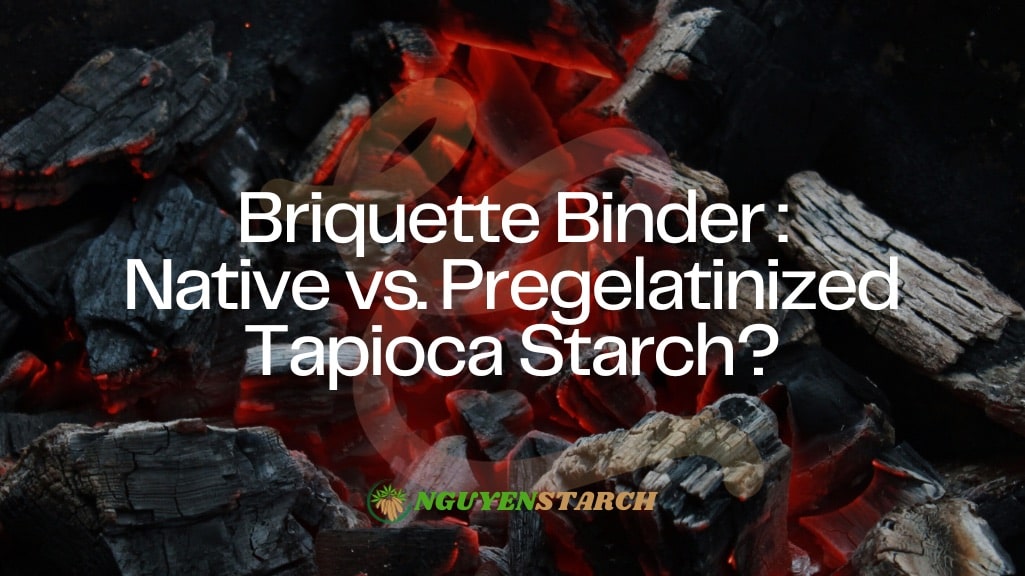When considering the use of tapioca starch as a binding agent for briquettes, it’s important to understand that there are two viable options: native tapioca starch and pregelatinized tapioca starch. These options come with distinct characteristics and advantages, and your choice between them should be driven by the specific requirements of your briquette manufacturing process.
Native Tapioca Starch
Native tapioca starch is extracted directly from the cassava root, maintaining its natural form with minimal processing, mainly involving washing and drying. This unprocessed nature lends it certain attributes.
This type of starch is frequently employed for its thickening and binding capabilities in various recipes. However, it might necessitate longer cooking times to fully unleash its thickening potential.
Native tapioca starch finds application in a range of industrial processes, including papermaking, adhesives, and as a binder for products like briquettes.
Advantages: Native tapioca starch, being in its natural state and minimally processed, possesses good binding properties for briquettes.
Considerations: It might require some cooking or heating to activate its binding properties, which could add complexity and time to the production process.
Pregelatinized Tapioca Starch
Pregelatinized tapioca starch has undergone additional processing. It’s precooked and then dried, resulting in starch granules that readily disperse in cold water, making it stand out for certain applications.
This modified starch can quickly and effectively thicken and bind at lower temperatures, making it a preferred choice for products like instant puddings and specific processed foods. Industries requiring rapid and consistent binding, such as tablet manufacturing, often favor this option.
Advantages: Pregelatinized tapioca starch has been pre-cooked and tailored to activate its binding properties at lower temperatures, offering quicker and more reliable binding without the need for extensive heating.
Considerations: It’s somewhat more processed compared to native tapioca starch, potentially impacting cost.
Potential Applications of Tapioca Starch in Briquettes Production
Tapioca starch can serve various purposes in the production of briquettes, enhancing their characteristics. Here are some potential applications of tapioca starch in briquette production:
Binder: Tapioca starch acts as a binder, bringing together the materials used in briquettes. When mixed with ingredients like charcoal fines, sawdust, or other biomass materials, it creates a cohesive blend that can be molded into briquettes, strengthening their structure and durability.
Improved Ignition Properties: When used as a binder, tapioca starch can improve the ignition properties of briquettes, making them easier to light and ensuring consistent ignition. This is especially valuable for products like charcoal briquettes used for grilling and heating.
Smoke Reduction: Incorporating tapioca starch into briquettes can help reduce smoke emissions during combustion. Smoke reduction is particularly desirable for household cooking and heating applications, as it contributes to a cleaner and more comfortable environment.
Enhanced Performance: Tapioca starch can be customized to enhance various aspects of briquette performance, including burn time, heat output, and combustion efficiency. It allows for optimization to suit specific applications.
Carbonization Process Enhancement: Tapioca starch can also influence the carbonization process itself, affecting properties like porosity, density, and other physical attributes to meet desired performance and quality standards.
Environmental Considerations: Tapioca starch is a natural and biodegradable material, making it an environmentally friendly choice for briquette production when compared to synthetic binders. This aligns with sustainability goals in certain applications.
How to Prepare Tapioca Starch Briquette Binder
Preparing a binder using tapioca starch for briquettes is a straightforward process. Here’s a step-by-step guide:
Ingredients and Materials:
- Tapioca starch (food-grade for cooking applications)
- Water
- Mixing bowl
- Mixing utensil (spoon or whisk)
- Stove or heating source (if needed)
Instructions:
- Measure the Tapioca Starch: Determine the amount of tapioca starch needed for your briquette production, depending on the specific recipe and the volume of briquettes you intend to make.
- Mix with Water: Place the tapioca starch in a mixing bowl and gradually add water while stirring continuously. Start with a ratio of around 1 part tapioca starch to 2 parts water, adjusting for desired consistency.
- Stir Thoroughly: Ensure there are no lumps by stirring the tapioca starch and water mixture thoroughly, aiming for a smooth and even slurry.
- Heat (if needed): Depending on your recipe and application, heat the mixture on a stove or suitable heating source while stirring to prevent sticking or clumping.
- Observe Consistency: Continue heating and stirring until the mixture reaches the desired consistency, typically a thick yet pourable binder for briquette production.
- Cool: Allow the binder to cool to room temperature; it will continue to thicken as it cools.
- Mix with Briquette Materials: Once cooled, combine the tapioca starch binder with other briquette materials like charcoal fines or sawdust, ensuring thorough distribution.
Food-grade or Industrial-grade Tapioca Starch for Briquette Production?
The choice between food-grade and industrial-grade tapioca starch for briquette production hinges on the specific application. For cooking or food-related purposes, it’s advisable to use food-grade tapioca starch, which adheres to higher quality and safety standards.
Industrial-grade tapioca starch, while less expensive, may contain impurities unsuitable for consumption. It is better suited for non-food applications such as heating or industrial processes.

